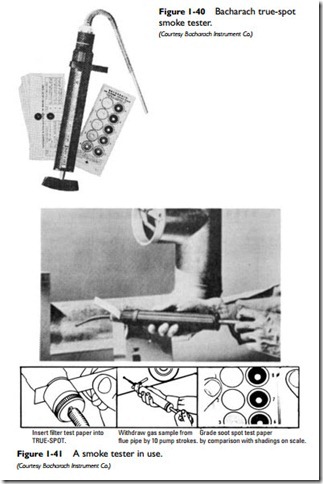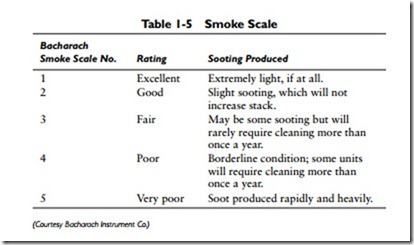Combustion Testing and Adjustments
The following instruments are recommended for combustion testing and adjustments:
• Draft gauge
• Smoke tester
• Carbon dioxide tester
• 200/1000F° stack thermometer
• 0/150-psig pressure gauge
• 0/30-inch mercury vacuum gauge
Smoky combustion indicates poor burner performance. The amount of smoke in the flue gas can be measured with a smoke tester (see Figure 1-40). The tube of the smoke tester is inserted through a 3⁄8-inch hole drilled in the flue pipe, and the test is run as shown in Figure 1-41. Any smoke in the air drawn into the smoke tester will register on a filter paper inserted in the device. The results are interpreted according to the smoke scale in Table 1-5.
One of the most common causes of smoky combustion is soot formation on the heating surfaces. This is easily corrected by cleaning. Other possible causes of smoky combustion include the following:
• Insufficient draft
• Poor fuel supply
• Fuel pump malfunctioning
• Defective firebox
• Incorrectly adjusted draft regulator
• Defective oil-burner nozzle
• Wrong size oil-burner nozzle
and 500F° for packaged units are considered abnormally high. The net stack temperature is the difference between the temperature of the flue gases inside the pipe and the room air temperature outside. For example, if the flue gas temperature is 600F° and the room tem- perature is 75F° , then the net stack temperature is 525F° (600F° –75F°525F).
A 200/1000F° stack thermometer is used to measure the flue gas temperature. The thermometer stem is inserted through a hole drilled in the flue pipe (see Figure 1-42). A high stack temperature may be caused by any of the following:
• Undersized furnace
• Defective combustion chamber
• Incorrectly sized combustion chamber
• Lack of sufficient baffling
• Dirty heating surfaces
• Excessive draft
• Boiler or furnace overfired
• Unit unsuited to automatic firing
• Draft regulator improperly adjusted
When the carbon dioxide (CO2) content of the flue gas is too low (less than 8 percent), heat is lost up the chimney and the unit operates inefficiently. This condition is usually caused by one of
the following:
• Underfiring the combustion chamber
• Burner nozzle is too small
• Air leakage into the furnace or boiler
When the carbon dioxide content is too high, the furnace operation is generally characterized by excess smoke and/or pulsations and other noises. A high carbon dioxide content is usually caused by insufficient draft or an overfired burner.
The carbon dioxide reading is also taken through a hole drilled in the flue pipe with a CO2 indicator (see Figure 1-43). The CO2 indicator is used as shown in Figure 1-44. The results are indicated by a test liquid on a scale calibrated in %CO2.
A correct draft is essential for efficient burner operation.
Insufficient draft can make it almost impossible to adjust the oil burner for its highest efficiency. Excessive draft can reduce the percentage of carbon dioxide in the flue gases and increase the stack temperature.
For the most efficient operating characteristics, the overfire draft generally should be not less than 0.02 inch wg. Smoke and odor often occur when the overfire draft falls below 0.02 inch wg.
It may be necessary to adjust the barometric draft regulator to obtain the correct overfire draft. If it is not possible to adjust the overfire draft for a 0.01 to 0.02 inch wg, install a mechanical draft inducer between the chimney and the barometric draft regulator.
The primary air band should be adjusted to a 0+ smoke or until a hard clean flame is visible. A clean flame is preferred to one with high carbon dioxide. Adjust the overfire draft for a 0.01 to a 0.02 inch wg. An excessive overfire draft condition will cause high stack temperature and inefficient operation. A too low or positive draft over the fire will usually cause the flue gases and fumes to seep into the space upon startup or shutdown.
The flue pipe draft in most residential oil burners is between and 0.06 inches of water. This is sufficient to maintain a draft of 0.02 inches in the firebox.
The furnace or boiler draft is measured with a draft gauge as shown in Figure 1-45. A hole is drilled in either the fire door (overfire draft measurement) or flue pipe (flue pipe draft measurement), and the unit is run for approximately 5 minutes. The draft tube is then inserted into the test hole, and the gauge is read (see Figure 1-46).



